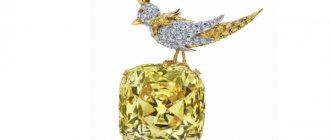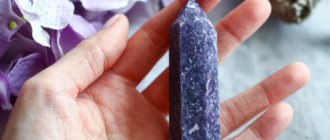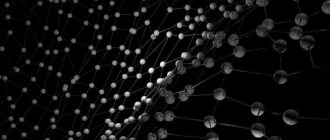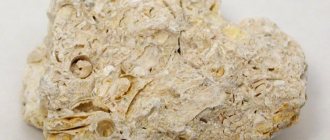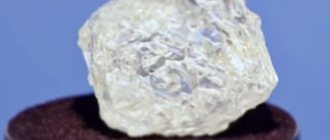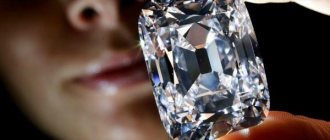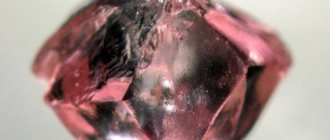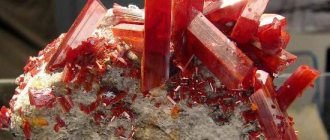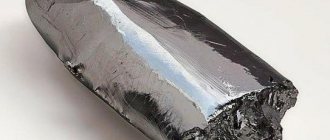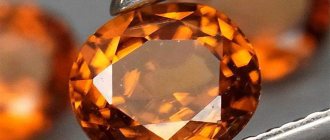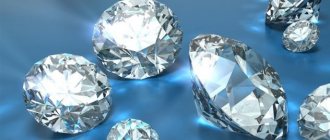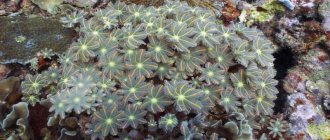507 carat Cullinan Heritage Diamond
Diamond
– the hardest mineral, cubic polymorphic (allotropic) modification of carbon (C), stable at high pressure. At atmospheric pressure and room temperature it is metastable, but can exist indefinitely without turning into graphite, which is stable under these conditions. In a vacuum or in an inert gas at elevated temperatures, it gradually turns into graphite.
- Structure
- Properties
- Morphology
- Origin
- Application
- Classification
- Physical properties
- Optical properties
- Crystallographic properties
See also:
Diamond
– price and medicinal, magical properties
Physical properties and structure of agate
STRUCTURE
Crystal structure of diamond
Diamond system is cubic, space group Fd3m. The elementary cell of the diamond crystal lattice is a face-centered cube, in which carbon atoms are located in four sectors arranged in a checkerboard pattern. Otherwise, the diamond structure can be represented as two cubic face-centered lattices, offset relative to each other along the main diagonal of the cube by a quarter of its length. A structure similar to diamond is found in silicon, a low-temperature modification of tin and some other simple substances. Diamond crystals always contain various defects in the crystal structure (point, linear defects, inclusions, subgrain boundaries, etc.). Such defects largely determine the physical properties of crystals.
Diamond Grading Criteria
When mining diamonds, only 60% of the minerals are suitable for processing; they are called jewelry. Naturally, the cost of uncut stones is significantly lower than the price of diamonds (more than twice). The valuation of diamonds is carried out according to the 4C system:
- Carat (weight in carats) - 1 carat is equal to 0.2 g.
- Color (color) - pure white diamonds are practically not found; most minerals have a certain shade. Its value largely depends on the color of a diamond; most stones found in nature have a yellow or brown tint; pink, blue and green stones are less commonly found. The rarest, most beautiful, and therefore most expensive are minerals of rich colors; they are called fancy. The rarest of them are green, purple and black.
- Clarity (purity) is also an important indicator that determines the presence of defects in the stone and significantly affects its cost.
- Cut – The appearance of a diamond greatly depends on the cut. The refraction and reflection of light, a kind of “diamond” shine, make this stone so valuable, and an incorrect shape or proportions during processing can completely ruin it.
PROPERTIES
Diamond in the Rough
Diamond can be colorless, water-transparent or colored in various shades of yellow, brown, red, blue, green, black, gray. The color distribution is often uneven, patchy or zonal. Under the influence of X-rays, cathode and ultraviolet rays, most diamonds begin to glow (luminesce) in blue, green, pink and other colors. Characterized by exceptionally high light refraction. The refractive index (from 2.417 to 2.421) and strong dispersion (0.0574) determine the bright shine and multi-colored “play” of cut jewelry diamonds, called brilliants. The shine is strong, from diamond to greasy. Density 3.5 g/cm3. According to the Mohs scale, the relative hardness of diamond is 10, and the absolute hardness is 1000 times higher than the hardness of quartz and 150 times higher than that of corundum. It is the highest among all natural and artificial materials. At the same time, it is quite fragile and breaks easily. The fracture is conchoidal. Does not interact with acids and alkalis in the absence of oxidizing agents. In air, diamond burns at 850° C with the formation of CO2; in a vacuum at temperatures above 1,500 ° C it turns into graphite.
How to distinguish natural stone from fake
Reference. Diamond is an expensive and beautiful stone; therefore, counterfeiting occurs more often than with other stones. Cubic zirconia is the main fake, which is very similar to diamond.
There are several ways to detect a fake:
- A natural mineral has 57 facets, fakes usually have fewer;
- natural stone has clear edges, unlike the rounded ones of the fake;
- with the help of a magnifying glass you can see doubling of edges in a fake, this cannot happen in the real thing;
- when UV rays are directed, the natural one begins to glow;
- when you run a marker over a stone, you can see a straight line;
- the diamond does not fog up.
MORPHOLOGY
Diamond morphology is very diverse. It occurs both in the form of single crystals and in the form of polycrystalline intergrowths (“board”, “ballas”, “carbonado”). Diamonds from kimberlite deposits have only one common flat-faceted shape - the octahedron. At the same time, diamonds with characteristic curved shapes are common in all deposits - rhombic dodecahedroids (crystals similar to a rhombic dodecahedron, but with rounded edges), and cuboids (crystals with a curved shape). As experimental studies and the study of natural samples have shown, in most cases, dodecahedroid-shaped crystals arise as a result of the dissolution of diamonds by kimberlite melt. Cuboids are formed as a result of the specific fibrous growth of diamonds according to the normal growth mechanism.
Cullinan diamond broken into 9 parts
Synthetic crystals grown at high pressures and temperatures often have cube faces and this is one of their characteristic differences from natural crystals. When grown under metastable conditions, diamond easily crystallizes in the form of films and columnar aggregates. The sizes of the crystals vary from microscopic to very large, the mass of the largest diamond, “Cullinan”, found in 1905. in South Africa 3106 carats (0.621 kg). Several months were spent studying the huge diamond, and in 1908 it was split into 9 large pieces. Diamonds weighing more than 15 carats are rare, but diamonds weighing over a hundred carats are unique and are considered rarities. Such stones are very rare and often receive their own names, world fame and their special place in history.
Chemical composition
Diamond is natural carbon. The peculiarity of the structure gives the mineral a transparent appearance. Nature rarely creates perfect stones, so most contain defects and impurities. The chemical composition of the crystal includes: nitrogen, aluminum, boron, magnesium, calcium, iron, copper, barium and silicon. Diamond components can include: solid, liquid and gaseous inclusions.
Diamond formula
The chemical formula of diamond is simple - element C. This is due to the fact that diamond is pure carbon, and the impurities included in its composition are very small, less than 15%, and therefore are not included in the formula. The serial number in the table is 6.
ORIGIN
Although diamond is metastable under normal conditions, due to the stability of its crystal structure, it can exist indefinitely without turning into a stable modification of carbon - graphite. Diamonds that are brought to the surface by kimberlites or lamproites crystallize in the mantle at a depth of 200 km. and more at a pressure of more than 4 GPa and a temperature of 1000 - 1300 ° C. In some deposits, there are also deeper diamonds brought from the transition zone or from the lower mantle. Along with this, they are carried to the Earth's surface as a result of explosive processes accompanying the formation of kimberlite pipes, 15-20% of which contain diamond.
Diamonds are also found in ultra-high pressure metamorphic complexes. They are associated with eclogites and deeply metamorphosed garnet gneisses. Small diamonds have been found in significant quantities in meteorites. They have a very ancient, pre-solar origin. They also form in large astroblemes - giant meteorite craters, where melted rocks contain significant amounts of fine-crystalline diamond. A well-known deposit of this type is the Popigai astrobleme in northern Siberia.
Diamonds
Diamonds are a rare, but at the same time quite widespread mineral. Industrial diamond deposits are known on all continents except Antarctica. Several types of diamond deposits are known. For several thousand years, diamonds have been mined from alluvial deposits. It was only towards the end of the 19th century, when diamond-bearing kimberlite pipes were first discovered, that it became clear that diamonds do not form in river sediments. In addition, diamonds were found in crustal rocks in associations of ultra-high pressure metamorphism, for example in the Kokchetav massif in Kazakhstan.
Both impact and metamorphic diamonds sometimes form very large deposits, with large reserves and high concentrations. But in these types of deposits, the diamonds are so small that they have no industrial value. Commercial diamond deposits are associated with kimberlite and lamproite pipes associated with ancient cratons. The main deposits of this type are known in Africa, Russia, Australia and Canada.
Ore mining process in Yakutia
The Mir kimberlite pipe was discovered on June 13, 1955, and development began in 1957. Its depth is 525 meters, which is slightly less than the height of the Ostankino TV tower. Between 1957 and 2001, diamonds worth seventeen and a half billion dollars were mined here. Until 2001, diamond mining was carried out in the open pit, but now it is mined in mines, that is, underground.
Mining is also carried out underground in the Internationalnaya kimberlite pipe, which is located 15 kilometers from Mirny. It is famous for its very high quality diamonds. Mining takes place at a depth of approximately one kilometer. The length of all workings is 37 kilometers. This mine began underground mining of minerals in Yakutia, despite the fact that the deposits are located in the permafrost zone.
Work at the mine is carried out in three shifts without weekends and holidays. One and a half thousand tons of rock-containing ore are mined per day. There cannot be empty ore here because specialists calculate the possibilities of the deposit in advance so that there are no losses .
The mined rock is sent to a processing plant, where the diamonds themselves are extracted. This process is quite lengthy and multi-step. The jaw crusher operates 24 hours a day. In 24 hours, six thousand tons of raw materials extracted from quarries and mines pass through it.
From the crusher, the raw materials are moved along a conveyor belt inside a huge mill with a diameter of 7 meters. Here, grinding occurs using water, with which the diamond-containing material is mixed, and then it falls on the so-called screens.
The stones are sifted like flour, passing through a sieve. During the process, they are divided into groups based on size. Large crystals are released in the separator. Diamond has the property of glowing in X-rays and then for some time after irradiation it continues to glow. The photocell sees this glow and cuts off large stones.
All these procedures may not be enough, and as a result, ordinary stones can sometimes be found among the diamonds. Only people can separate the precious material completely and irrevocably. They finish by hand what the machines started.
APPLICATION
Good crystals are cut and used in jewelry. About 15% of mined diamonds are considered jewelry, another 45% are considered near-jewelry, that is, inferior to jewelry in size, color or clarity. Currently, global diamond production is about 130 million carats per year. Diamond
(from the French brillant - brilliant), is a diamond that has been given a special shape through mechanical processing (cutting), a brilliant cut, which maximizes the optical properties of the stone such as brilliance and color dispersion.
Very small diamonds and fragments, unsuitable for cutting, are used as an abrasive for the manufacture of diamond tools necessary for processing hard materials and cutting the diamonds themselves. The cryptocrystalline variety of diamond, black or dark gray in color, forming dense or porous aggregates, is called Carbonado
, has a higher abrasion resistance than diamond crystals and is therefore especially valued in industry.
Small crystals are also grown artificially in large quantities. Synthetic diamonds are obtained from various carbon-containing substances, mainly from graphite, in special. apparatuses at 1200-1600°C and pressures of 4.5-8.0 GPa in the presence of Fe, Co, Cr, Mn or their alloys. They are suitable for technical use only.
Diamond – C
| Molecular weight | 12.01 g/mol |
| origin of name | From Greek, adamas, meaning “invincible” or “solid.” |
| IMA status | valid, first described before 1959 (before IMA) |
Diamond processing
Diamond processing requires enormous experience, knowledge and skills. Before starting work, it is necessary to thoroughly study the stone in order to subsequently preserve its weight as much as possible and get rid of inclusions. The most common type of diamond cut is round; it allows the stone to sparkle with all its colors and reflect light as favorably as possible. But this type of work is also the most difficult: a round diamond has 57 planes, and when cutting it, it is important to maintain precise proportions. Also popular types of cuts are: oval, teardrop, heart, marquise, emerald and others. There are several stages of mineral processing:
- marking;
- splitting;
- sawing;
- rounding;
- cut.
It is still believed that after processing a diamond loses about half of its weight.
PHYSICAL PROPERTIES
| Mineral color | colorless, yellowish-brown fading to yellow, brown, black, blue, green or red, pink, cognac brown, blue, lilac (very rare) |
| Stroke color | no |
| Transparency | transparent, translucent, opaque |
| Shine | diamond, bold |
| Cleavage | octahedron perfect |
| Hardness (Mohs scale) | 10 |
| Kink | uneven |
| Strength | fragile |
| Density (measured) | 3.5 – 3.53 g/cm3 |
| Radioactivity (GRapi) | 0 |
| Thermal properties | High thermal conductivity. It feels cold to the touch, which is why diamond is called “ice” in slang. |
Manufacturing of artificial diamonds
Now technology makes it possible to “grow” diamonds that are practically indistinguishable from natural ones. There are several synthesis methods:
- The creation of HPHT diamonds is the closest method to natural conditions. Minerals are created from graphite and seed diamond at a temperature of 1400 ° C under a pressure of 50,000 atmospheres. This method makes it possible to synthesize gem-quality stones.
- The creation of CVD diamonds (film synthesis) is the production of stones under vacuum conditions using a seed and gases of methane and hydrogen. This method makes it possible to synthesize the purest minerals, but of extremely small sizes, which is why they are mainly used for industrial purposes.
- Explosive synthesis is a method that produces small diamond crystals through the detonation of explosives and subsequent cooling.
OPTICAL PROPERTIES
| Type | isotropic |
| Refractive indices | nα = 2.418 |
| Maximum birefringence | δ = 2.418 – isotropic, does not have birefringence |
| Optical relief | moderate |
| Optical axis dispersion | strong |
| Pleochroism | does not pleochroate |
| Luminescence in ultraviolet radiation | sometimes blue or phosphorescent |
